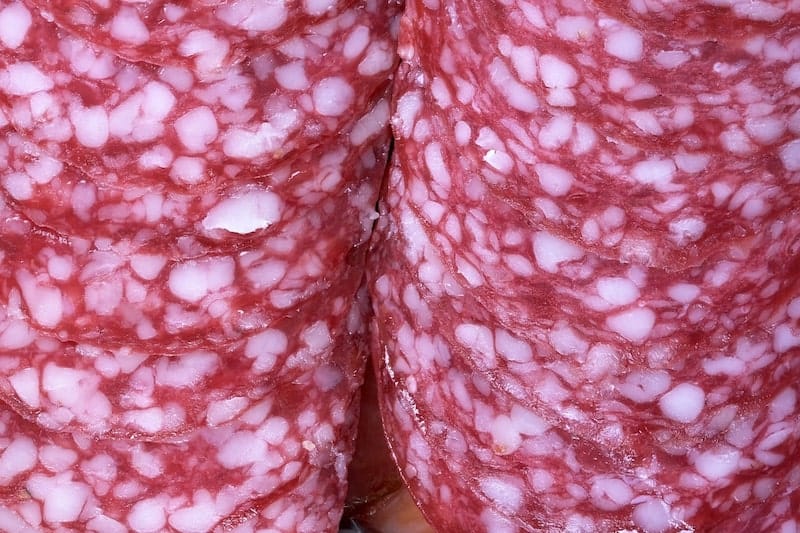Is Uncured Salami Healthy?
When you’re designing the perfect charcuterie board, salami is an integral part of the process. The same applies when layering a delicious submarine sandwich. But we often hear that cured sausage isn’t the best for our health.
Even the World Health Organization has issued a warning against cured sausages, such as salami. But if cured sausages aren’t healthy, is uncured salami healthy? The most accurate answer is – it depends.
On its own merits, uncured salami is a relatively healthy choice. However, as is the case with all meat products, moderation is essential. Although, compared to the cured salami, it might be a healthier option.
In this article, I’ll cover everything you need to know about cured and uncured salami and any potential health benefits either of them might have.
Salami: The Basics
Before we can dive into the differences between cured and uncured salami, we must take a step back. Is any type of salami healthy?
There’s a lot of controversy around the health benefits of red meat, in general, but there are also nutritional facts we need to consider.
Salami is a type of sausage that goes through a curing and fermentation process. Usually, salami is made with pork, but other meats, such as beef, are an option.
Other ingredients may include pepper, garlic, salt, and vinegar. The goal is to reach the perfect pH level indicated by the presence of white penicillin-based mold. This type of mold is safe and safe for consumption.
Now, let’s take a closer look at the nutritional data about salami.
Good Source of Protein and Fats
It probably doesn’t come as a surprise to learn that salami is an excellent source of protein. The main ingredient is dried meat high in this macronutrient.
Protein is essential because it builds and repairs muscles and other vital tissues. Furthermore, eating enough protein is crucial to stay satiated throughout the day.
Salami also contains high levels of saturated fats. However, when consumed in moderation, that’s great, as fat is another essential macronutrient.
Not a Good Source of Carbohydrates
The carb content in salami will depend on how much sugar is used in the seasoning mix. During the fermentation process, the sugar content from the mixture will eventually decrease, leaving a nominal amount behind.
It’s not all bad news, though.
Although you may not receive many carbs, the fermentation process makes beneficial bacteria that are good for your gut health.
Contains a Lot of Sodium
Sodium is a scary word these days, but there’s no reason for that to be the case.
On the contrary, eating too much or too little sodium is equally bad for your health. Indeed, salami contains a lot of sodium, so it’s essential to be careful how much you consume.
Cured Salami vs. Uncured Salami?
Curing sausage is the process of preserving them without refrigeration. This is something humans learned to do long before we modernized food storage.
Uncured salami doesn’t mean it hasn’t undergone processing. It only means that the additives used are not artificial.
Cured salami is cured with the help of special chemicals and additives, and uncured salami requires natural additives, salts, and flavorings.
The most used preservative for salami is sodium nitrite, along with the mixture of salt. The average content of sodium nitrate in any amount of salami needs to be under 1%.
Cured sausages, in general, tend to have a more pinkish color than uncured options and a longer shelf life.
Uncured salami, on the other hand, doesn’t taste much different than cured varieties. This is because all uncured sausage requires celery powder or other natural preservatives for processing, just like its cured counterpart. However, when salami doesn’t contain sodium nitrite, it’s labeled ‘uncured.’
The lack of artificial nitrites is what gives ‘uncured’ salami its distinction. However, the celery powder added during processing will transform into nitrite in the same way that artificial additives do.
The resulting product is like its cured counterpart in many ways, including taste. However, uncured salami also might contain more sodium to prevent spoilage, which could also qualify it as potentially unhealthy.
The ultimate difference comes down to the question of whether you want artificial additives in your salami or not.
It’s also possible that some butchers choose not to use any curing mixture and sell the salami meat fresh. In that case, you need to be the one to cure it. Then, of course, you can choose to cook it, but it’s not going to taste anything like cured salami.
Why Are Nitrates Bad for You?
The problem with nitrates in food is that they cannot be broken down by stomach acid.
Instead, the gut biome transforms the nitrate into nitrite, which is a well-known cancerogenic. Consuming excessive amounts of nitrates can lead to an increased risk of cancer and even complications during pregnancy.
How to Minimize the Impact of Nitrates Consumed With Salami
Compared to some processed meats available these days, salami is considered high-quality and not unhealthy. Therefore, the main issue with salami is the quantity eaten, not the quality.
Whether you choose the cured or plant-based, uncured option, the sodium and nitrate presence will have an impact on your health, both positively and negatively, to different degrees. It depends on which type of salami you eat.
The naturally occurring nitrates in plants and added to uncured salami are not harmful to our health. They typically come with vitamin C or other antioxidants that inhibit the conversion into nitrites.
Some salami manufacturers have started adding vitamin C to their products to mimic this benefit. However, you don’t have to search for salami with vitamin C to minimize the harmful impact. You can increase the consumption of foods that contain high levels of antioxidants instead.
For example, you can eat some broccoli or beets next time you eat salami. Drinking green tea, eating onions, and spinach are also great options.
In addition, incorporating seaweed into your diet and preparing turmeric tea can increase the antioxidant intake if you consume processed meats frequently.
In Summary
So, is uncured salami healthy? The answer is yes, but not significantly healthier than cured salami. The plant-based preservative is indeed a more nutritious option, but adding it to the meat will also promote the creation of nitrates.
No evidence suggests that natural preservatives are entirely healthy and that much better than sodium nitrate.
These days, the term ‘uncured salami’ doesn’t mean that the meat is not processed, just that it relies on natural ingredients. It’s up to each person individually to determine what works better for them.








